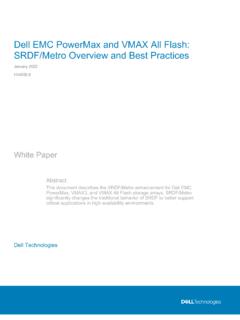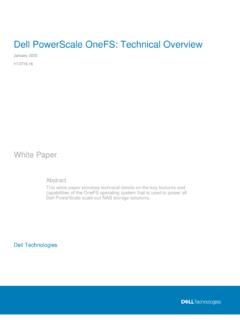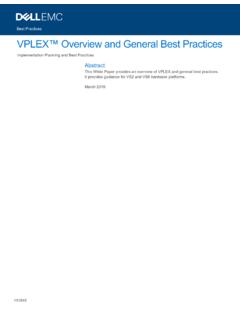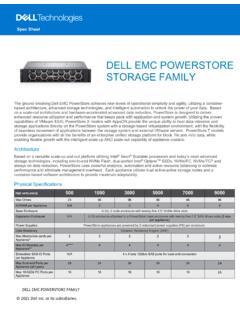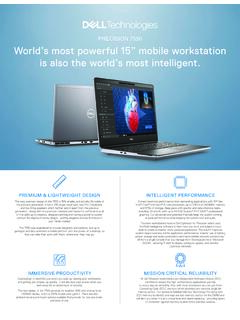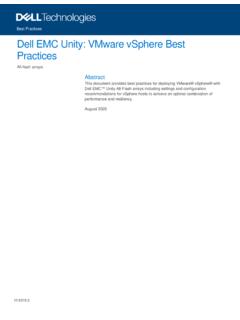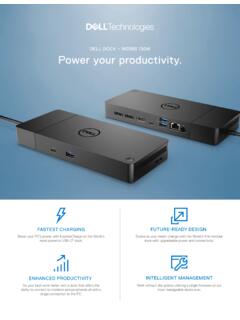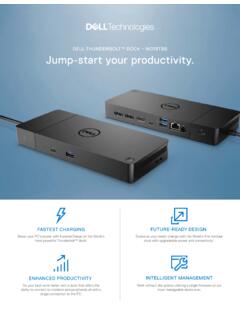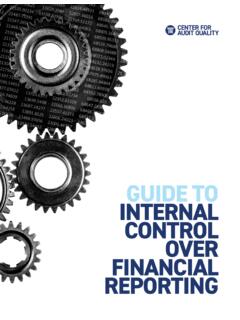Transcription of Dell PowerStore: Best Practices Guide
1 Dell PowerStore: Best Practices Guide January 2022. White Paper Abstract This document provides best Practices for installing and configuring Dell PowerStore for optimal performance and availability. Dell Technologies Copyright The information in this publication is provided as is. Dell Inc. makes no representations or warranties of any kind with respect to the information in this publication, and specifically disclaims implied warranties of merchantability or fitness for a particular purpose. Use, copying, and distribution of any software described in this publication requires an applicable software license. Copyright 2020-2022 Dell Inc. or its subsidiaries. All Rights Reserved. Dell Technologies, Dell, EMC, Dell EMC and other trademarks are trademarks of Dell Inc. or its subsidiaries. Intel, the Intel logo, the Intel Inside logo and Xeon are trademarks of Intel Corporation in the and/or other countries. Other trademarks may be trademarks of their respective owners.
2 Published in the USA January 2022 Dell Inc. believes the information in this document is accurate as of its publication date. The information is subject to change without notice. 2 Dell PowerStore: Best Practices Guide Contents Contents Executive Introduction ..4. Hardware Network considerations ..9. PowerStore storage PowerStore features and layered applications ..12. External host considerations ..13. References ..15. Dell PowerStore: Best Practices Guide 3. Executive summary Executive summary Overview This white paper provides best Practices guidance for using Dell PowerStore in a mixed- business environment. It focuses on optimizing system performance and availability, and on maximizing the usability of the automated storage features. These guidelines are intended to cover most use cases. They are recommended by Dell Technologies but are not strictly required. Some exception cases are addressed in this white paper. Less common edge cases are not covered by these general guidelines and are addressed in use case specific white papers.
3 For questions about the applicability of these guidelines in a specific environment, contact your Dell Technologies representative to discuss the recommendations. Audience This document is intended for IT administrators, storage architects, partners, and Dell Technologies employees. This audience also includes any individuals who may evaluate, acquire, manage, operate, or design a Dell networked storage environment using PowerStore systems. Revisions Date Description April 2020 Initial release: PowerStoreOS June 2020 Terminology updates September 2020 Terminology updates June 2021 PowerStoreOS updates January 2022 PowerStoreOS updates; template update Introduction Document This document introduces specific configuration recommendations that enable optimal purpose performance from PowerStore. PowerStore PowerStore achieves new levels of operational simplicity and agility. It uses a container- overview based microservices architecture, advanced storage technologies, and integrated machine learning to unlock the power of your data.
4 PowerStore is a versatile platform with a performance-centric design that delivers multidimensional scale, always-on data reduction, and support for next-generation media. PowerStore brings the simplicity of public cloud to on-premises infrastructure, streamlining operations with an integrated machine-learning engine and seamless automation. It also offers predictive analytics to easily monitor, analyze, and troubleshoot the environment. PowerStore is highly adaptable, providing the flexibility to host specialized workloads directly on the appliance and modernize infrastructure without disruption. It also offers investment protection through flexible payment solutions and data-in-place upgrades. 4 Dell PowerStore: Best Practices Guide Introduction Terminology The following table provides definitions for some of the terms that are used in this document. Table 1. Terminology Term Definition Appliance A solution containing a base enclosure and any attached expansion shelves.
5 The size of an appliance could be only the base enclosure or the base enclosure plus expansion shelves. Base enclosure Refers to the enclosure that contains both nodes (node A and node B) and 25 NVMe drive slots. Cluster One or more appliances in a single grouping and management interface. Clusters are expandable by adding more appliances to the existing cluster, up to the allowed amount for a cluster. Embedded module Connectivity card in the PowerStore node that provides ports for Ethernet connections, and various service and management ports. Expansion enclosure Enclosures that can be attached to a base enclosure to provide additional storage in the form of SAS drives. Fibre Channel A protocol used to perform NVMe or SCSI commands over a Fibre Channel (FC) network. File system A storage resource that can be accessed through file-sharing protocols such as SMB or NFS. Internet SCSI (iSCSI) Provides a mechanism for accessing block-level data storage over network connections.
6 I/O module Optional connectivity cards that provide additional Fibre Channel or Ethernet ports. IOPS I/Os per second, a measure of transactional performance for small-block workloads. MBPS Megabytes per second, a measure of bandwidth performance for large-block workloads. Network-attached storage A virtualized network-attached storage server that uses the (NAS) server SMB, NFS, or FTP/SFTP protocols to catalog, organize, and transfer files within file system shares and exports. A NAS. server, the basis for multi-tenancy, must be created before creating file-level storage resources. A NAS server is responsible for the configuration parameters on the set of file systems that it serves. Network File System (NFS) An access protocol that allows data access from Linux/UNIX. hosts on a network. Node A storage node that provides the processing resources for performing storage operations and servicing I/O between storage and hosts. NVMe over Fibre Channel Allows hosts to access storage systems across a Fibre (NVMe/FC) Channel network fabric using the NVMe protocol.
7 NVMe over TCP (NVMe/TCP) Allows hosts to access storage systems across a TCP network fabric using the NVMe protocol. Dell PowerStore: Best Practices Guide 5. Hardware considerations Term Definition PowerStore Command Line An interface that allows a user to perform tasks on the storage Interface (PSTCLI) system by typing commands instead of using the user interface (UI). PowerStore T model Container-based storage system that is running on purpose- built hardware. This storage system supports unified (block and file) workloads or block optimized workloads. PowerStore X model Container-based storage system that is running inside a virtual machine that is deployed on a VMware hypervisor. In addition to the block optimized workloads that this storage system offers, it also allows users to deploy applications directly on the array, through AppsON functionality. Server Message Block (SMB) An access protocol that allows remote file data access from clients to hosts on a network.
8 This is typically used in Microsoft Windows environments. Snapshot A point-in-time view of data stored on a storage resource. A. user can recover files from a snapshot, restore a storage resource from a snapshot, or provide access to a host. Thin clone A read/write copy of a volume, volume group, file system, or snapshot that shares blocks with the parent resource. Virtual Volumes (vVols) A VMware storage framework which allows VM data to be stored on individual VMware vSphere Virtual Volumes (vVols). This allows for data services to be applied at a VM-granularity level while using Storage Policy Based Management (SPBM). Volume A block-level storage device that can be shared out using a protocol such as iSCSI or Fibre Channel. We value your Dell Technologies and the authors of this document welcome your feedback on this feedback document. Contact the Dell Technologies team by email. Author: Ethan Stokes Contributor: Stephen Wright Note: For links to other documentation for this topic, see the PowerStore Info Hub.
9 Hardware considerations Introduction At the highest level, design for optimal performance follows a few simple rules. The main principles of designing a PowerStore system for performance are: Distribute workloads across available resources Simplify the configuration Design for resilience Maintain the latest-released PowerStoreOS version Hardware components are the foundation of any storage system. This section discusses some key hardware differences between PowerStore models that help determine 6 Dell PowerStore: Best Practices Guide Hardware considerations performance. It also explains how different configuration options can result in different performance from the same hardware. PowerStore The PowerStore platform consists of six different models, from the PowerStore 500 model deployment through the PowerStore 9000 model. All models use a common base enclosure and I/O. modes modules. The models differ by CPU core count and speed, memory size, and number of NVMe NVRAM drives.
10 These hardware differences give each model a unique performance profile. Besides the hardware differences between the models, PowerStore can be installed in one of three different deployment modes. Each deployment mode has different capabilities, as detailed in Table 2. Choose the deployment mode that provides the required capabilities. Table 2. PowerStore configurations External External file AppsON. Deployment mode block access access functionality PowerStore T model: Unified X. PowerStore T model: Block optimized X X. PowerStore X model X . Note: The PowerStore 500 is only available as a T model (either unified or block optimized). The PowerStore system has different performance characteristics depending on deployment mode. PowerStore T models PowerStore T models run the PowerStoreOS directly on the hardware. PowerStore T. models can be installed in a unified configuration that provides file and block access, or in a block optimized configuration that provides only block access.
